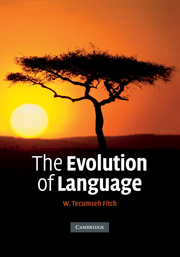Book contents
- Frontmatter
- Contents
- List of figures
- Acknowledgments
- Introduction
- SECTION 1 THE LAY OF THE LAND
- 1 Language from a biological perspective
- 2 Evolution: consensus and controversy
- 3 Language
- 4 Animal cognition and communication
- SECTION 2 MEET THE ANCESTORS
- SECTION 3 THE EVOLUTION OF SPEECH
- SECTION 4 EVALUATING PHYLOGENETIC MODELS OF LANGUAGE EVOLUTION
- Glossary
- Appendix: species names
- References
- Author index
- Subject index
- Species index
4 - Animal cognition and communication
Published online by Cambridge University Press: 05 June 2012
- Frontmatter
- Contents
- List of figures
- Acknowledgments
- Introduction
- SECTION 1 THE LAY OF THE LAND
- 1 Language from a biological perspective
- 2 Evolution: consensus and controversy
- 3 Language
- 4 Animal cognition and communication
- SECTION 2 MEET THE ANCESTORS
- SECTION 3 THE EVOLUTION OF SPEECH
- SECTION 4 EVALUATING PHYLOGENETIC MODELS OF LANGUAGE EVOLUTION
- Glossary
- Appendix: species names
- References
- Author index
- Subject index
- Species index
Summary
Those who deny understanding to the higher animals, can have very little themselves.
– Arthur SchopenhauerAt the turn of the twentieth century, a remarkable horse named Hans was paraded through Germany by his owner Wilhelm von Osten, a horse trainer and high-school mathematics teacher. Not only could “Clever Hans” understand complex questions put to him in plain German – “If Tuesday falls on the eighth of the month, what date is the following Friday?” – but he could answer them by tapping out the correct number with his hoof. Using this simple response, it appeared that Hans could add, subtract, multiply, and divide, tell the time, understand the calendar, and both read and spell words. Suspicious, the German board of education appointed a commission, including circus trainers, veterinarians, teachers, and psychologists, to investigate the situation. Surprisingly, they concluded in 1904 that no trickery was involved. This did not satisfy the board, and the case was passed to psychologist Oskar Pfungst for experimental investigation. Braving both the horse's and owner's notoriously bad tempers, Pfungst finally was able to demonstrate that Hans was no mathematician, but rather a fine observer of human behavior (Pfungst, 1911). In a story now told to countless “Intro Psych” students, Pfungst demonstrated that Hans could only answer questions correctly when: (1) the questioner knew the answer; and (2) Hans could see the questioner.
- Type
- Chapter
- Information
- The Evolution of Language , pp. 143 - 202Publisher: Cambridge University PressPrint publication year: 2010



